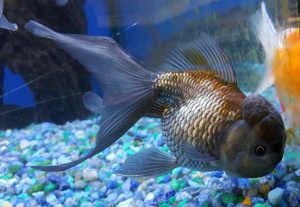Oranda Goldfish (Carassius auratus) are known to tropical fish keeping enthusiasts as Holland Ironmask goldfish, Wen, Flower of the Water, or Fancy Oranda, and are arguably one of the most popular goldfish breeds in the world.
Like all goldfish breeds, Orandas are descendants of a species of Central Asian (Siberian) wild carp known as the Prussian Carp, Silver Prussian carp, or Gibel Carp (Carassius gibelio).
Oranda goldfish are distinguished by a prominent bubble like head growth or hood on the head known as the wen, or crown. Except for the eyes and mouth, the fleshy growth in mature specimens can completely encase the head of the fish.
Except for their heads, Oranda goldfish are similar to Veiltail Goldfish. They have a short rounded or egg shaped body, with shimmering (almost metallic looking) scales, a split fan tail that is shorter than the Veiltail. Except for their split tail fin, their fins are paired and unlike the Lionhead goldfish, they posses a dorsal fin.
Orandas are available in a plethora of colors which is often incorporated in their name description.
Their metallic or matte scales can be colored black, red, white, calico, black and white, chocolate, white with a red Wen, bronze, and recently even a rare blue variety.
The fleshy Wen begins to develop in the Oranda when the fish is about 3 or 4 months old, but it takes about two years for the hood to become fully developed. Although it is impossible to sex young Oranda goldfish, the males are generally smaller and slimmer than the females. During the breeding season the male develops white prickles, called breeding tubercles, on their head and gill covers and the females, when viewed from above, are much fatter in appearance.
Oranda Goldfish are best housed in a tank of at least 30 gallon capacity with a medium gravel substrate, decorated with some colder water plants, a piece of driftwood or bogwood, some smooth rocks, and floating plants
to diffuse overhead lighting. Their Wen is somewhat delicate and bacterial infections can become a problem with sharp edged rocks, driftwood, or decomposing plants. They are scavengers and will try to uproot live plants, especially when planted in fine gravel or a sandy substrate.
Orandas are a social species that should be housed (uncrowded) with at least 4 or 5 of their own kind. They are a peaceful, slow moving species that should be kept with other slow moving relatives like the Lionhead Goldfish, Telescope Goldfish, and Celestial Eye Goldfish. These are all delicate, slow moving varieties with poor vision, that when housed together should get plenty to eat.
All goldfish produce a tremendous amount of waste. They need regular water changes and a good
filtration system that does not create a strong flow of current in the tank. Orandas require a lot of oxygen, so an air stone is recommended along with a tank that provides the maximum amount of surface area (breeder tank) per fish.
Like all species of goldfish, the fancy Oranada Goldfish is not a true tropical fish. They are a cold water species that does best at temperatures between 65 – 72° F but unlike other goldfish species, they cannot tolerate temperatures under 60° F. They can tolerate salinity levels below 10% and specific gravity less than 1.002.
Orandas are egg layers that are relatively easy to breed in an aquarium environment. In the wild, they always breed during the spring in groups as small as five individuals.
To mimic springtime breeding conditions in an aquarium environment, you will first need to stock some healthy fish into a breeding tank planted with Anacharis or other oxygenating plants. Some solid surfaces (like clean slate) and/or spawning mops should be provided for the eggs to adhere to.
Induce spawning by feeding the fish live brine shrimp, worms, etc. several times a day, slowly lowering the water temperature to around 60° F, and then slowly warming the water approximately 3° F per day until spawning commences. Spawning activity will usually occur when the water temperature reaches between 68° and 74° F. During this process, the water quality in the breeding tank should be maintained with daily partial water changes of up to 20 %.
When the fish are ready to spawn, the male will push the female against the plants to stimulate her. She will drop tiny eggs that when fertilized by the males will adhere to the plants, slate, or spawning mops by sticky threads. Females can lay as many as 10,000 eggs per spawn over a period of three to four hours.
Separate the parents from the eggs immediately after spawning as the parents will devour as many eggs as possible. Depending on the water temperature, the fertilized eggs will hatch in 4 to 7 days. Feed the fry specialty fry foods until they are able to consume crushed goldfish flakes or brine shrimp.
Fancy Oranda Goldfish are omnivorous and will eat all kinds of fresh, frozen, and flake foods. A good quality flake food with supplemental feedings of live, frozen, or freeze dried brine shrimp, blood worms, daphnia, or tubifex worms will keep them free of parasites or bacterial infections.
Avoid overfeeding but because of their poor vision, allow them plenty of time to eat before removing any excess food from the tank.
Oranda Goldfish are relatively inexpensive and readily available in most tropical fish keeping shops and online as juveniles and/or adults. The fancier and rarer color variations like the blue scale variety are usually much more expensive.
Minimum Tank Size: 20-30 gallons
Care Level: Moderately Difficult
Temperament: Peaceful
Aquarium Hardiness: Moderately Hardy
Water Conditions: 65-72° F, KH 2-15, pH 6.5-8.0
Max. Size: 7″
Color Form: Black, Red, White, Blue
Diet: Omnivore
Compatibility: Other slow moving species
Origin: Asia, China, Farm Raised
Family: Cyprinidae
Lifespan: 10-20 years
Aquarist Experience Level: Intermediate




